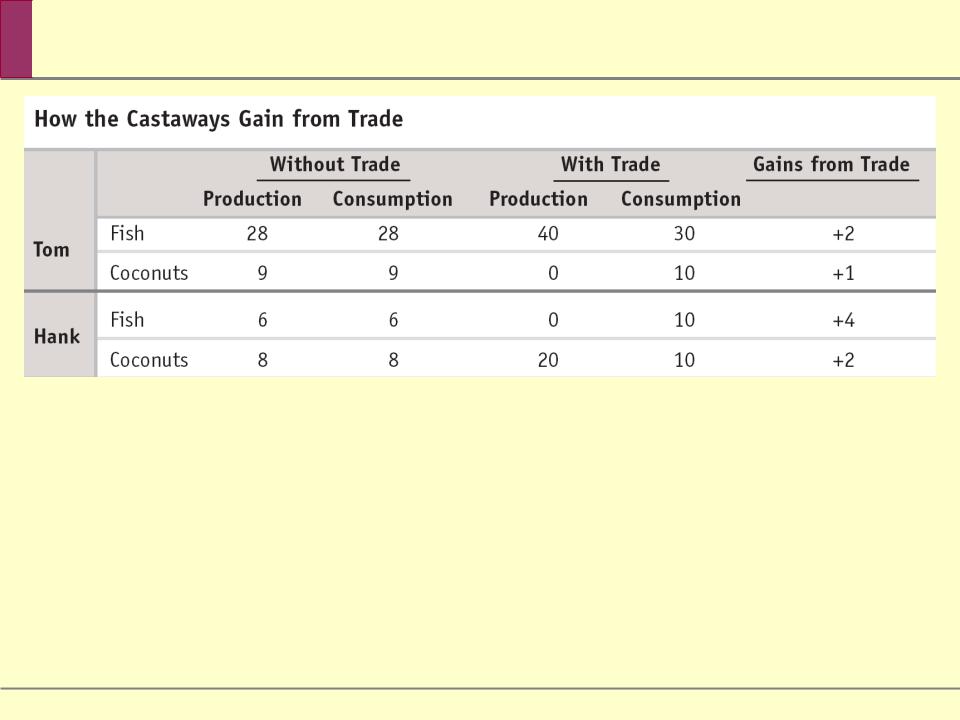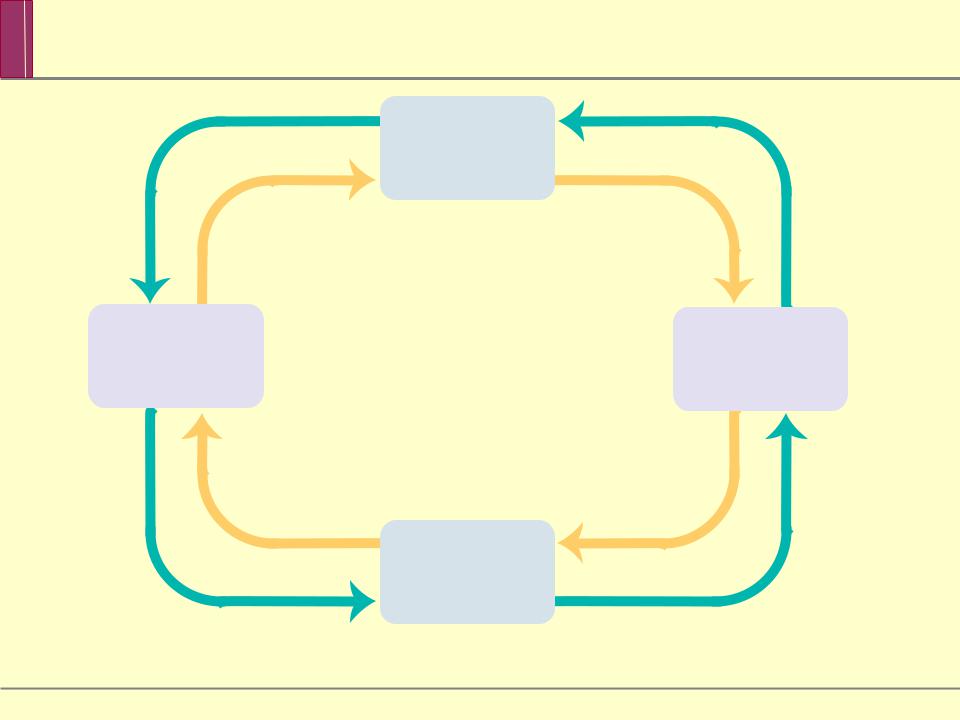
Microeconomics_presentation_Chapter_2
.pdf

 Specialize and Trade
Specialize and Trade
Both castaways are better off when they each specialize in what they are good at and trade.
It’s a good idea for Tom to catch the fish for both of them, because his opportunity cost of a fish in terms of coconuts not gathered is only 3/4 of a coconut, versus 2 coconuts for Hank.
Correspondingly, it’s a good idea for Hank to gather coconuts for the both of them.

Tom’s |
(b) Hank’s Production and Consumption |
Quantity of coconuts |
Quantity of coconuts |
|
Hank’s production |
|
|
with trade |
|
Tom’s consumption |
|
|
with trade |
Hank’s consumption |
|
|
with trade |
|
Tom’s production |
Hank’s consumption |
|
with trade |
||
without trade |
||
|
||
Tom's |
PPF |
|
PPF |
0 |
30 |
Quantity of "sh |
0 |
Quantity of "sh |
|
|
|


 How the Castaways Gain from Trade
How the Castaways Gain from Trade
Both Tom and Hank experience gains from trade:
Tom’s consumption of fish increases by two, and his consumption of coconuts increases by one.
Hank’s consumption of fish increases by four, and his consumption of coconuts increases by two.


 Comparative vs. Absolute Advantage
Comparative vs. Absolute Advantage
An individual has a comparative advantage in producing a good or service if the opportunity cost of producing the good is lower for that individual than for other people.
An individual has an absolute advantage in an activity if he or she can do it better than other people. Having an absolute advantage is not the same thing as having a comparative advantage.


 Tom vs. Hank – Absolute vs. Comparative
Tom vs. Hank – Absolute vs. Comparative
Tom has an absolute advantage in both activities: he can produce more output with a given amount of input (in this case, his time) than Hank.
But we’ve just seen that Tom can indeed benefit from a deal with Hank because comparative, not absolute, advantage is the basis for mutual gain.
So Hank, despite his absolute disadvantage, even in coconuts, has a comparative advantage in coconut gathering.
Meanwhile Tom, who can use his time better by catching fish, has a comparative disadvantage in coconut-gathering.

Advantage and
(a) |
(b) Canadian Production Possibilities Frontier |
Quantity of |
Quantity of aircraft |
|
Canadian production |
|
|
with trade |
|
U.S. consumption |
|
|
without trade |
Canadian |
|
U.S. consumption |
||
consumption |
||
with trade |
||
without trade |
||
|
||
U.S. |
Canadian |
|
production |
consumption |
|
with trade |
with trade |
|
0 |
0 |
|
|
Quantity of pork (millions of tons) |

Comparative Advantage and International Trade
Just like the example of Tom and Hank, the U.S. and Canada can both achieve mutual gains from trade.
If the U.S. concentrates on producing pork and ships some of its output to Canada, while Canada concentrates on aircraft and ships some of its output to the U.S., both countries can consume more than if they insisted on being self-sufficient.


 Transactions: The Circular-Flow Diagram
Transactions: The Circular-Flow Diagram

-
Markets for goods and services
Households |
Money |
Goods
and Factors services
Factor Markets
Goods
and Factors services
Money |
Firms |
Money |


 Circular-Flow of Economic Activities
Circular-Flow of Economic Activities
A household is a person or a group of people that share their income.
A firm is an organization that produces goods and services for sale.
Firms sell goods and services that they produce to households in markets for goods and services.
Firms buy the resources they need to produce— factors of production—in factor markets.
